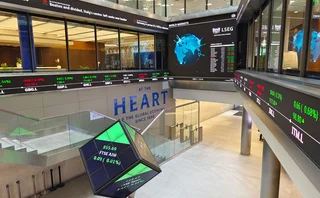
Structured products house of the year: SG CIB
Banks needed agility as well as scale to succeed in structured products in 2015

Risk Awards 2016
The past 12 months have been hectic for structured products issuers. In Europe, regulatory pressures continued to incentivise a shift towards listed, standardised products, a segment that rewards firms that can operate at industrial scale. At the same time, the thirst for more engineered products – from autocallable variants for Asian retail clients, to credit-linked notes among financial institutions – benefited dealers with the ability to dissect and distribute the resulting array of exotic risks.
Societe Generale Corporate & Investment Banking (SG CIB) showed it could handle both sets of demands last year. The bank has poured capital and manpower into its European listed products franchise as part of an ambitious growth plan. In 2013, it had a maximum of 30,000 products listed on European bourses. By the fourth quarter of 2015, it was pricing more than 120,000.
"The regulatory constraints we are living with today in structured products mean we see a need to diversify points of access for our mass retail clients. Regulators are more comfortable with the listed business, so being an active player here is a good way to achieve this diversification," says Julien Lascar, head of sales for Europe ex-France in the cross-asset solutions team at SG CIB in London.
Germany, the largest market for listed products in Europe, has been the linchpin of its growth strategy, with the bank fully aware of the ground it had to make up to catch local rivals. While competing on popular vanilla products such as turbos and warrants was a key plank of this growth strategy, SG CIB also focused on filling niches neglected by other houses.
The firm is already reaping the benefits of this two-pronged approach, says Lascar. It broke into the top 10 dealers in listed products in Germany last year and is aiming for a top eight spot by the end of 2016. SG CIB estimates it has increased revenues across the listed franchise by 50% since the implementation of the growth plan.
Clients are impressed: "They were one of the first to launch a range-accrual product referencing the DAX and are now very competitive in a segment where they were nowhere 18 months ago. Across product classes, the reliability of their quotes is strong. SG is also one of the few issuers, post-trade, asking us about pricing and providing an after-sales service. It is climbing strongly," says a senior executive at one listed products brokerage in Germany.
SG CIB sees listed growth as a complement, rather than a threat, to its core private placement and distribution businesses. In 2015, the bank reshuffled its desks to seat its structured products and flow derivatives teams next to one other – a move Marc El Asmar, London-based global head of equity and derivatives sales at SG CIB, says was designed "to create the sort of broad product spectrum needed in an environment where neither institutional nor distribution clients are interested in the differences between structured and vanilla, but are more concerned with products that could contend with low interest rates and shaky equity markets."
The regulatory constraints we are living with today in structured products mean we see a need to diversify points of access for our mass retail clients
Julien Lascar, SG CIB
In addition, greater authority is afforded to regional managers within the integrated structured and flow teams, who now oversee the full range of products sold in their jurisdiction.
The approach was put to the test in early September 2015 during the storm that afflicted the Korean retail autocallable market following the collapse in Hong Kong equities. SG CIB was one of a number of international dealers that rode the boom in worst-of autocallables, which typically reference baskets of indexes including the HSCEI, Kospi 200, and Euro Stoxx 50. This market had grown from a modest 492 billion won ($435 million) in 2009 to 94.4 trillion won by the end of June 2015 – a near-190-fold increase.
Sales of these products lumped dealers with a host of exotic risks – including vega, skew and quanto correlation – that fluctuated in response to the spot levels of the indexes they tracked. When the HSCEI nosedived from a high of 14,900 in April to a low of 9,100 in early September, SG CIB's sensitivity to the exotic risks linked to this index rocketed.
At this point, the bank's equity derivatives franchise kicked into gear to manage the structured desk's HSCEI vega and skew positions through the buying or selling of vanilla options, as well as variance swaps with sophisticated clients. With every issuer of autocallables axed the same way, not all were able to fully cover their position as buyers of volatility became scarce. SG CIB, though, had the advantage of a large and diversified client base to draw upon.
"While we heard others experienced losses on the HSCEI volatility skew, our risk management was resilient and the vega losses were actually minimal compared to the notional traded or the business profitability," says Arie Boleslawski, deputy head of trading at the bank in London.
Quanto correlation woes
Where it and many other dealers did suffer, however, was on the quanto correlation between the HSCEI and HKD/KRW. Though Korean-issued autocallables are denominated in won, the derivatives used to hedge the HSCEI bought and sold by the dealers are denominated in Hong Kong dollars. Dealers are naturally long this correlation, as they do not want their HSCEI hedges to diminish in value if HKD falls out of step with KRW.
SG was less exposed to losses than its competitors thanks to its access to a roster of canny buy-side firms interested in taking quanto covariance risk, says Boleslawski, which meant it did not have to rely on a few large private placements to offset the risk.
"The fact we got rid of part of our quanto exposure allowed us to continue to quote throughout the last quarter of 2015. Obviously, the demand is lower, but because some competitors have moved out, profitability will be higher. It was a decent quarter for our Korean business and we continue to be ready to propose trades," he adds.
In total, Boleslawski says SG CIB's losses on its Korean autocallable hedges were in the low double-digit millions of dollars. Globally, profit-and-loss across the autocallable franchise was up 10% on 2014.
While equity-linked structures dominated in 2015, as the boom in autocallables demonstrates, SG CIB also stood out from the crowd thanks to advances in credit. The appetite for this asset class is growing among financial institutions, such as insurers, thanks to its return profile.
SG CIB has positioned itself to satisfy this appetite, becoming a dominant issuer of medium-term notes, with more than twice the share of the second-placed bank, according to mtn-i, a data provider.
SG is now very competitive in a segment where it was nowhere 18 months ago
German structured products broker
Yet with spreads tightening last year on Markit's iTraxx index – which is referenced by vanilla credit-linked notes (CLNs) – SG CIB began offering investors notes that allowed them to effectively sell protection on a mezzanine tranche of the iTraxx Crossover – saving them from exposure to yield-sapping senior names and risky sub-investment grade names. Sales of these mezzanine tranches through SG's notes programme boomed to more than half a billion of notional issued.
The success of this business relied, however, on the firm's ability to pick its way through some tricky hedging obligations. Under Europe's regulatory capital requirements, the cost to SG CIB had it retained the exposure on the senior and sub-investment-grade names would have bitten deeply into the spread it could offer on the mezzanine tranche.
These costs are likely to increase as a result of the Fundamental Review of the Trading Book (FRTB), which was finalised in early 2016.
SG CIB has sought to tackle the problem head-on by drawing in a variety of clients to share the exposure it had acquired.
"We are monitoring ex-ante the capital cost that may occur when the FRTB is implemented, and to avoid it, we have done two things: put limits on the forward capital consumption for credit and offloaded our residual exposure by selling equity stakes on high-yield names in the index and buying protection on the super-senior tranche," says Boleslawski.
SG CIB offered private clients two innovative structures that help it package and offload the tranches left over from the sale of mezzanine notes referencing the iTraxx Crossover – the ‘switchable linear' and ‘rainbow' CLNs.
 "We have clients interested in different parts of the capital structure, and we can combine those directly into products based on the capacity of clients to take more or less risk. If we sell a switchable linear, we end up having an excess senior part, but if we sell a rainbow, we can offset this," says Thomas Decouvelaere (pictured), co-head of European pricing and development in the global markets team at the bank in London.
"We have clients interested in different parts of the capital structure, and we can combine those directly into products based on the capacity of clients to take more or less risk. If we sell a switchable linear, we end up having an excess senior part, but if we sell a rainbow, we can offset this," says Thomas Decouvelaere (pictured), co-head of European pricing and development in the global markets team at the bank in London.
The bank's bond repack franchise was another success story last year. French insurance companies in particular have acquired a taste for these instruments as a means to enhance yields on their holdings of inflation-linked sovereign bonds and secure protection from future interest rate rises. In a typical transaction, a bank swaps the fixed cashflows of a French OATi for a floating coupon linked to a point on the constant maturity swap curve. The insurer pays for this by accepting a below-par fixed rate for the first few years of the repack's tenor.
SG CIB has stolen a march on its competitors by becoming the first bank to offer callable repacks. The added optionality boosts the coupons an insurer can receive for the fixed-term period without compromising the underlying sovereign credit. For example, one structure sold to a French insurance company – callable at the five-year point and annually thereafter – provided a 70 basis points pick-up versus a vanilla product.
Issuance of these callable repacks reached €300 million in notional in 2015, with the bank bolstering its pricing and modelling capabilities for short-term bond options, allowing it to enhance liquidity at the longer end of the curve, too.
Only users who have a paid subscription or are part of a corporate subscription are able to print or copy content.
To access these options, along with all other subscription benefits, please contact info@risk.net or view our subscription options here: http://subscriptions.risk.net/subscribe
You are currently unable to print this content. Please contact info@risk.net to find out more.
You are currently unable to copy this content. Please contact info@risk.net to find out more.
Copyright Infopro Digital Limited. All rights reserved.
As outlined in our terms and conditions, https://www.infopro-digital.com/terms-and-conditions/subscriptions/ (point 2.4), printing is limited to a single copy.
If you would like to purchase additional rights please email info@risk.net
Copyright Infopro Digital Limited. All rights reserved.
You may share this content using our article tools. As outlined in our terms and conditions, https://www.infopro-digital.com/terms-and-conditions/subscriptions/ (clause 2.4), an Authorised User may only make one copy of the materials for their own personal use. You must also comply with the restrictions in clause 2.5.
If you would like to purchase additional rights please email info@risk.net
More on Awards
Clearing house of the year: LCH
Risk Awards 2025: LCH outshines rivals in its commitment to innovation and co-operation with clearing members
Best use of machine learning/AI: CompatibL
CompatibL’s groundbreaking use of LLMs for automated trade entry earned the Best use of machine learning/AI award at the 2025 Risk Markets Technology Awards, redefining speed and reliability in what-if analytics
Markets Technology Awards 2025 winners’ review
Vendors jockeying for position in this year’s MTAs, as banks and regulators take aim at counterparty blind spots
Equity derivatives house of the year: Bank of America
Risk Awards 2025: Bank gains plaudits – and profits – with enhanced product range, including new variants of short-vol structures and equity dispersion
Law firm of the year: Linklaters
Risk Awards 2025: Law firm’s work helped buttress markets for credit derivatives, clearing and digital assets
Derivatives house of the year: UBS
Risk Awards 2025: Mega-merger expected to add $1 billion to markets revenues, via 30 integration projects
Interest rate derivatives house of the year: JP Morgan
Risk Awards 2025: Steepener hedges and Spire novations helped clients navigate shifting rates regime
Currency derivatives house of the year: UBS
Risk Awards 2025: Access to wealth management client base helped Swiss bank to recycle volatility and provide accurate pricing for a range of FX structures







